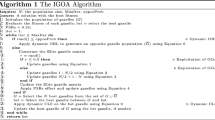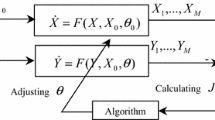Abstract
This paper presents an enhanced version of the Learner Performance-based Behavior (LPB), a novel metaheuristic algorithm inspired by the process of accepting high-school students into various departments at the university. The performance of the LPB is not according to the required level. This paper aims to improve the performance of a single objective LPB by embedding ten chaotic maps within LPB to propose Chaotic LPB (CLPB). The proposed algorithm helps in reducing the Processing Time (PT), getting closer to the global optima, and bypassing the local optima with the best convergence speed. Another improvement that has been made in CLPB is that the best individuals of a sub-population are forced into the interior crossover to improve the quality of solutions. CLPB is evaluated against multiple well-known test functions such as classical (TF1_TF19) and (CEC_C06 2019). Additionally, the results have been compared to the standard LPB and several well-known metaheuristic algorithms such as Dragon Fly Algorithm (DA), Genetic Algorithm (GA), and Particle Swarm Optimization (PSO). Finally, the numerical results show that CLPB has been improved with chaotic maps. Furthermore, it is verified that CLPB has a great ability to deal with large optimization problems compared to LPB, GA, DA, and PSO. Overall, Gauss and Tent maps both have a great impact on improving CLPB.

Similar content being viewed by others
Data availability
The datasets generated during and/or analysed during the current study are not publicly available but are available from the corresponding author on reasonable request.
References
Du K-L, Swamy MNS (2016) Search and optimization by metaheuristics. Springer International Publishing, Cham. https://doi.org/10.1007/978-3-319-41192-7
Rahman CM, Rashid TA (2021) A new evolutionary algorithm: learner performance based behavior algorithm. Egypt Inform J 22(2):213–223. https://doi.org/10.1016/j.eij.2020.08.003
Bezdek JC (1992) On the relationship between neural networks, pattern recognition and intelligence. Int J Approx Reason 6(2):85–107. https://doi.org/10.1016/0888-613x(92)90013-p
Lu H, Wang X, Fei Z, Qiu M (2014) The effects of using chaotic map on improving the performance of multiobjective evolutionary algorithms. Math Probl Eng. https://doi.org/10.1155/2014/924652
Javidi M, Hosseinpourfard R (2015) Chaos genetic algorithm instead genetic algorithm. Int Arab J Inf Technol 12(2):163–168
Jain M, Kumar I (2023) Genetic algorithm in the single server inventory retrial queueing system with time and stock level dependent customer arrival rate. Int J Inf Technol 15(8):4537–4549. https://doi.org/10.1007/s41870-023-01440-2
Gandomi AH, Yang X-S (2014) Chaotic bat algorithm. J Comput Sci 5(2):224–232
Kohli M, Arora S (2017) Chaotic grey wolf optimization algorithm for constrained optimization problems. J Comput Des Eng 5(4):458–472. https://doi.org/10.1016/j.jcde.2017.02.005
Kaur G, Arora S (2018) Chaotic whale optimization algorithm. J Comput Des Eng 5(3):275–284. https://doi.org/10.1016/j.jcde.2017.12.006
Mohammed HM, Rashid TA (2021) Chaotic fitness-dependent optimizer for planning and engineering design. Soft Comput 25(22):14281–14295. https://doi.org/10.1007/s00500-021-06135-z
Verma A, Dhanda N, Yadav V (2022) Binary particle swarm optimization based edge detection under weighted image sharpening filter. Int J Inf Technol 15(1):289–299. https://doi.org/10.1007/s41870-022-01127-0
Chhikara R, Sharma P, Chandra B, Malik N (2023) Modified Bird Swarm Algorithm for blind image steganalysis. Int J Inf Technol 15(6):2877–2888. https://doi.org/10.1007/s41870-023-01355-y
Attuluri S, Ramesh M (2023) Multi-objective discrete harmony search algorithm for privacy preservation in cloud data centers. Int J Inf Technol 15(8):3983–3997. https://doi.org/10.1007/s41870-023-01462-w
Nakra A, Duhan M (2022) Deep neural network with harmony search based optimal feature selection of EEG signals for motor imagery classification. Int J Inf Technol. https://doi.org/10.1007/s41870-021-00857-x
Biswas HR, Hasan MM, Bala SK (2018) Chaos theory and its applications in our real life. Barishal Univ J Part 1 1(5):123–140
Mirjalili S (2015) Dragonfly algorithm: a new meta-heuristic optimization technique for solving single-objective, discrete, and multi-objective problems. Neural Comput Appl 27(4):1053–1073. https://doi.org/10.1007/s00521-015-1920-1
Price KV, Awad NH, Ali MZ, Suganthan PN (2018) The 100-digit challenge: problem definitions and evaluation criteria for the 100-digit challenge special session and competition on single objective numerical optimization, Nanyang Technological University, Technical Report, Singapore
Liang JJ, Suganthan PN, Deb K (2005) Novel composition test functions for numerical global optimization, in Proceedings of the 2005 IEEE Swarm Intelligence Symposium, 2005. SIS 2005, pp 68–75 [online] (Proceedings of 2005 IEEE), pp 68–75. Available at: https://ieeexplore.ieee.org/document/1501604. Accessed 10 June 2005
Hamad RK, Rashid TA (2024) GOOSE algorithm: a powerful optimization tool for real-world engineering challenges and beyond. EvolvingSystems. https://doi.org/10.1007/s12530-023-09553-6
Abdullah JM, Ahmed T (2019) Fitness dependent optimizer: inspired by the bee swarming reproductive process. IEEE Access 7:43473–43486. https://doi.org/10.1109/ACCESS.2019.2907012
Hama Rashid DN, Rashid TA, Mirjalili S (2021) ANA: ant nesting algorithm for optimizing real-world problems. Mathematics 9:3111. https://doi.org/10.3390/math9233111
Mohammed H, Rashid T (2023) FOX: a FOX-inspired optimization algorithm. Appl Intell 53:1030–1050. https://doi.org/10.1007/s10489-022-03533-0
Ahmed S et al (2019) Donkey and smuggler optimization algorithm: a collaborative working approach to path finding. J Comput Des Eng 6(4):562–583. https://doi.org/10.1016/j.jcde.2019.04.004
Abdulhameed S, Rashid TA (2022) Child drawing development optimization algorithm based on child’s cognitive development. Arab J Sci Eng 47:1337–1351. https://doi.org/10.1007/s13369-021-05928-6
Acknowledgements
The authors would like to thank the University of Kurdistan-Hewler for providing facilities for this research work.
Funding
This study was not funded.
Author information
Authors and Affiliations
Corresponding author
Ethics declarations
Conflict of interest
The authors declare that they have no conflict of interest.
Ethical approval
This article does not contain any studies with human participants or animals performed by any of the authors.
Rights and permissions
Springer Nature or its licensor (e.g. a society or other partner) holds exclusive rights to this article under a publishing agreement with the author(s) or other rightsholder(s); author self-archiving of the accepted manuscript version of this article is solely governed by the terms of such publishing agreement and applicable law.
About this article
Cite this article
Franci, D.A., Rashid, T.A. CLPB: chaotic learner performance based behaviour. Int. j. inf. tecnol. (2024). https://doi.org/10.1007/s41870-024-01875-1
Received:
Accepted:
Published:
DOI: https://doi.org/10.1007/s41870-024-01875-1




